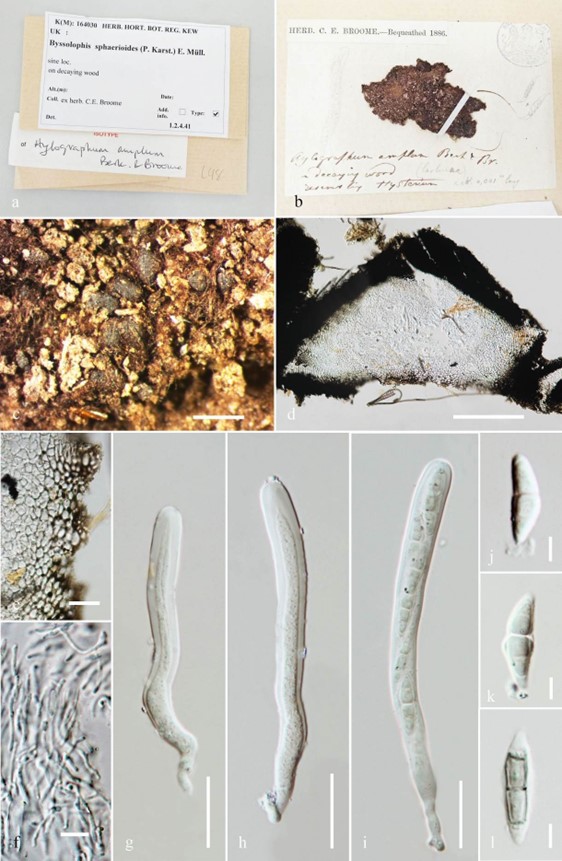Byssolophis sphaerioides (Nyl. ex P. Karst.) E. Müll., in Müller & von Arx, Beitr. Kryptfl. Schweiz 11(no. 2): 341 (1962) Fig. 14
≡ Hysterographium sphaerioides Nyl. ex P. Karst., Not. Sällsk. Fauna et Fl. Fenn. Förh. 11: 258 (1870) [1871]
MycoBank number: MB 327224;Index Fungorum number: IF 327224; Facesoffungi number: FoF 06225;
Saprobic on decaying wood. Sexual morph: Ascomata 105–238 μm high × 169–373 μm diam ( x = 133.5 × 346.9 μm, n = 10), hysterothecial, superficial or sunken in substrate, oval to elongate, or globose to subglobose, dark brown to black, carbonaceous, glabrous, straight or curved, with a subiculum, with brown hyphae. Ostiole slit-like, with a small to large, flat, crest-like apex. Peridium 21– 45 μm thick at the sides, broad at the apex and thinner at the base, dark brown, comprising a singl\e stratum of dark brown cells of textura angularis in the inside and thin-walled cells of textura prismatica in the exterior part. Hamathecium comprising 1–1.9 μm wide, cylindrical to filiform pseudoparaphyses in a gelatinous matrix. Asci 50–89 μm × 8.7–8.9 μm ( x = 74.5 × 8.9 μm, n = 10), 8-spored, bitunicate, fissitunicate, elongate cylindric-clavate, straight or slightly curved, short-pedicellate, apically rounded, with an ocular chamber. Ascospores 18–26 μm × 5–6 μm ( x = 21 × 6 μm, n = 10) overlapping bi-seriate, narrowly fusiform to broadly cylindrical, straight or slightly curved, 1–3-septate, hyaline to pale brown, smooth, surrounded by a narrow appendage-like sheath. Asexual morph: Undetermined.
Material examined – Unknown, on decaying wood, ex herb C.E. Broome, 1886, (K (M) 164030, isotype).
Economic significance – None is reported.

Figure 14 – Byssolophis sphaerioides (K (M) 164030, isotype). a–b Herbarium specimen and habit on leaf. c Appearance of ascomata on the host surface. d Section of ascoma. e Peridium. f Hamathecium. g–i Asci. j–l Ascospores. Scale bars: c = 500 μm, d = 100 μm, e = 50 μm, f = 10 μm, g–i = 20 μm, j–l = 5 μm.
